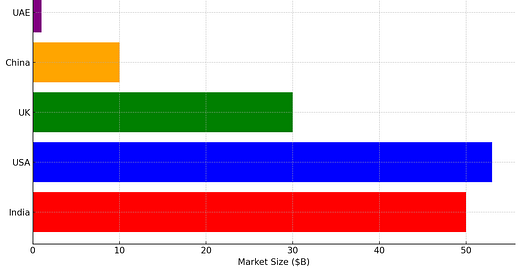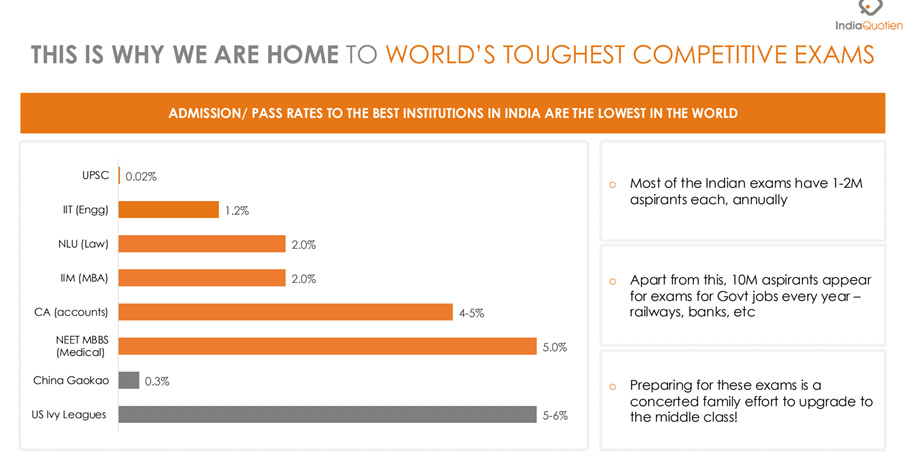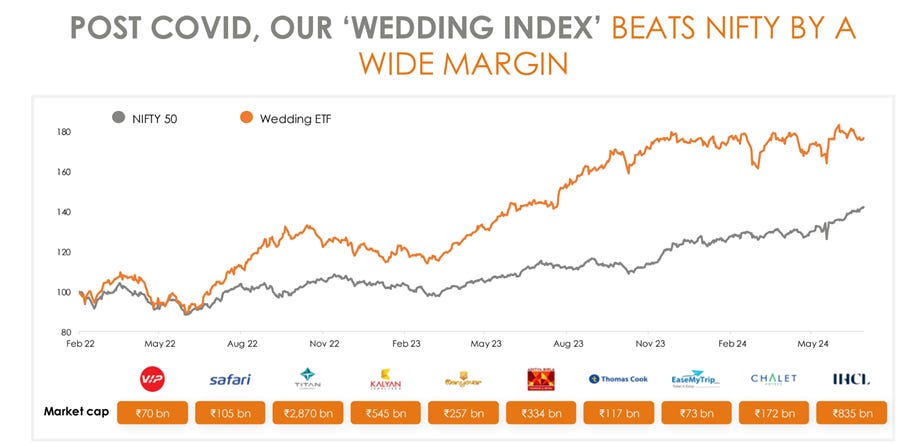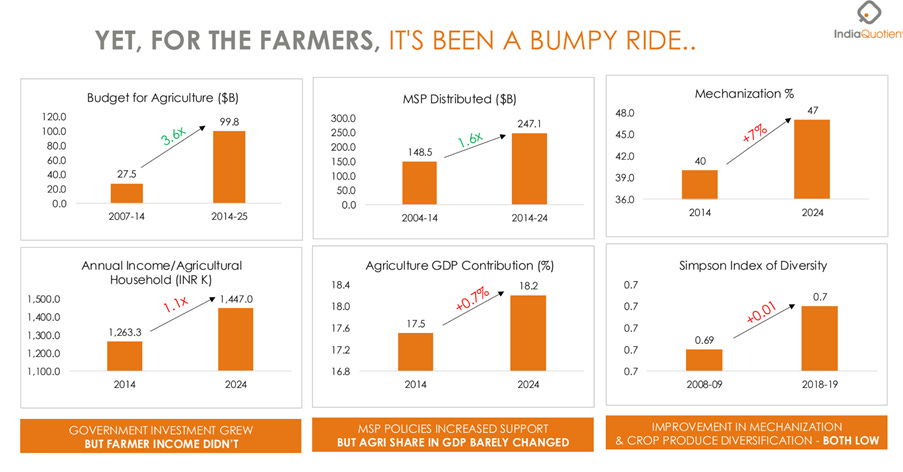India Insights 2025: Key Trends Shaping India’s Future | Episode 43
India Quotient's new report is easy, fun read with some major insights
Was just going through India Quotient’s latest report on trends in the country and few things really stood out – Crazy rise in rural internet penetration, increasing love for gaming, how late marriages is good business for IVF and much more!
India is undergoing a rapid transformation, shaped by increasing digital adoption, shifting consumer habits, and a wave of innovation across industries. What also is very clear that India is a land of contradictions - we have taken some amazing strides in digitizing how we live and consume, but we still are unable to do real manufacturing. The list of contradictions is long.
Let’s dive deeper into the report and some of it’s key insights! All image credits to IQ’s team. They have done a fantastic job in creating this one.
1. The Digital Boom: A Nation Hooked on Screens
India’s digital landscape is expanding at an unprecedented rate, with rural areas driving much of the growth. Some of the key takeaways are -
Content is King: India has 121 major languages, over 900 licensed TV channels, and the largest YouTube creator community globally. For e.g. Pushpa 2 sold 18M+ tickets on BookMyShow, a record-breaking feat.
Internet has penetrated rural India deeply: While 40% of India’s population still lacks full internet access, rural areas are leading growth in OTT (54%), social media (75%), and digital payments (46%). Smartphone adoption has also skyrocketed, with rural users now comprising 54% of India's 820M active internet users.
5G has been the Game Changer: India's 5G penetration stands at 23% (2024) but is projected to surpass 65% by 2029. Low-cost data at $0.09/GB drives internet usage, though device affordability remains a barrier.
UPI Auto-Pay Revolution: UPI transactions have increased 411x since 2016, fueling India's shift toward a pay-per-use economy, including microtransactions for digital services, entertainment, and education.
Now, we do spend a ridiculously high amount of time online and the question below is pertinent – Do we love spending time on our screens or is it a symptom of something much more problematic? Do we, as a country, have lesser work to do?
Yes, we are a nation hooked on screens and it means good business, it does pose a lot more questions than it answers. Also, what does this mean in terms of future affordability of the population?
2. Education: The Pursuit of the Indian Dream
India’s education sector is evolving rapidly, blending technology, international opportunities, and cutthroat competition. There are some clear trends in the Indian education scene -
The Study Abroad Boom: India ranks 5th globally for IB schools, with enrollments growing at 40% CAGR. Over 750,000 Indian students are currently studying abroad, a 3x increase since 2015.
Competitive Exam Pressure: Acceptance rates highlight the intensity—IIT (2%), IIM (5%), UPSC (0.02%). Coaching institutes thrive in this environment, with Kota alone generating $800M annually. On a lighter note, maybe the graph below puts the debate of which exams is the toughest to rest – UPSC/IIT/IIM are the toughest to crack, CA/MBBS not so much! CA I would have imagined, but MBBS? That’s an interesting one.
One of the most crucial takeaway here is that education has almost priced itself out of everyone’s reach – till around a decade back, IIT/IIM/BITS/NIT/MBBS used to be the “jump into the highest socio-economic” kind of deal. With ~10-15x rise in education, both in private as well as public sector colleges, this is becoming more and more difficult. This doesn’t bode well for a country with a per capita income of less than USD 3,000! We need those colleges and need them available to everyone who can get in.
3. The Big Fat Indian Wedding Industry
Now, this is an interesting segment to analyse. The implications are far, weird and makes me angry/sad, all at the same time. Indian weddings are an economic powerhouse, merging tradition with multi-billion-dollar spending.
$50B Market: Indian weddings account for 10% of the global wedding industry, outpacing markets like China and the UK.
Luxury Destination Weddings: 5,000+ high-end Indian weddings take place abroad each year, resulting in $14B in lost revenue. The government is actively promoting "Wed in India" to retain spending.
New Family Trends: Delayed marriages have fueled a 5.3x increase in India's IVF market ($4B by 2030) and 3x growth in the pet industry (76M pets by 2030).
And yes, Indians are crazy for education, but not as crazy as they are weddings! We save and spend more on our weddings than on our education, even now!
And while markets have returned good money , even taking into consideration the current slowdown, the wedding basket has done fantastic! Do take a closer look at the companies mentioned here in the below image!
4. Rural India’s Rise: More Money, More Digital
With 65% of India’s population living in rural areas, these communities are increasingly driving consumption and digital expansion.
Spending Boom: Discretionary spending now accounts for 30% of rural household budgets, reflecting rising aspirations.
Digital Penetration Soars: With increasing smartphone adoption, rural internet penetration is set to reach 85% by 2025. Worryingly, while Infra has definitely improved and more people are browsing/scrolling away their times, it looks like basics such as Healthcare or education hasn’t really improved a lot in the last decade or so.
Regional Brands vs. National Giants: 30-40% of FMCG categories, including edible oils, biscuits, and snacks, are controlled by regional brands, which outperform national giants in affordability and distribution.
And for fintech firms like us at UNLEASH, this is important - the hospital beds per population is very, very, very low. And health insurance coverage is nothing to speak about! Large white space here to solve for this. Fintech+healthtech to do well in the coming decade?
While it looks like few things gave gone well for the rural India, a lot more needs to be done here!
5. Agriculture: Balancing Growth with Challenges
Despite India’s deep agricultural roots, farmers still struggle with low incomes and systemic inefficiencies. While we are #1 in production of milk, pulses, spices, cotton, jute and population of cattle herds globally, these have not really translated well into increased incomes or quality of life for farmers.
Stagnant Farm Incomes: Despite $247B in MSP payments since 2014, the average farmer's annual income is $1,447 (₹1.2L), compared to $3,752 in the U.S.. Annual income per agricultural household has increased by a grand total of ~10% in the last decade!
Mechanization Lags: India's 47% mechanization rate is far behind the 95% in the U.S. and China. This is both an outcome as well a cause for the poor yields that we have.
Post-Harvest Wastage: 40% of food produce is lost due to supply chain inefficiencies.
There are major loopholes in the entire value chain which attracts quite a significant number of startups in the space. In fact, we have been looking to invest actively in the agri financing space across the entire value chain.
The issue with startups here have been that almost all of them are caught in the GMV game and real solutions/revenues have been hard to come by. More harder has been the “replace the middleman” thesis. Maybe the trick is to work with them and use tech for better profitability instead of focussing just on efficiency? And please, come out of building the marketplace phase?
6. Consumer brands in India: The rise of the Raja Betas
Oh, how much I loved this section! I see this theme playing every day, in and out, pushed more and more by the social media frenzy.
Everyone wants a white collar job and everyone wants to buy branded stuff- problem is, income levels have not increased in the white collar jobs. So the “pretense” that one is rich while being actually not has increased a lot. And VCs/PEs are playing this well.
In terms of brands successs, it does look like there is an understanding that there’s a limit to how much you can sell online and one needs to go offline to sell!
I do agree with his – Offline is where the big money is!
7. Manufacturing in India: Still far away from being an asset
I have been seeing this theme across industries – Indians are relatively poor when it comes to work ethics as well as labour quality itself and it shows – we have done well in capital intensive industries, but fared poorly in labour intensive ones!
And it’s been very clear since some time now that India is not China +1! We don’t have the temperament for this!
And India is not really cheap when it labor, but delivers 1/8th the value per hour compared to Taiwan!
Even in terms of govt. initiatives, it looks like job creation more than capability creation. Something needs to change here if we really want to do well here!
8. And a section on kids
Well, the kids are becoming costlier to educate and maintain. And hence, pet parenting has become a big deal – good VC interest in the space shows the same thing.
Declining fertility rates, increase age of mothers and kids who never grow up – some of the real problems. Maybe in a different newsletter?
Final Thoughts: The Road Ahead
India is transforming at an unprecedented pace. Success in this evolving landscape will come from those who localize offerings, leverage technology, and cater to India’s unique socio-economic dynamics. Whether it’s digital adoption, rural consumption growth, or AI-led innovation, India’s future is bright and full of opportunities. The report was an easy read with some major insights for sure!
There are white spaces in each of the segment discussed above for fintech players. Happy to discuss this more! Do reach out to me at abhishek.kumar@unleashcp.com in case you are building in financial services/fintech space.
Disclaimer – The views presented here are my own and doesn’t reflect views of my employer in any way and it shouldn’t be construed as that in any way whatsoever.






















